I have been wanting t write on this topic for awhile; the benefits of oak trees. Oak trees have so many benefits, and it can be difficult to go into them all in a single post. That is why I have broken the topic of oak trees into different posts, so you can learn how to plant them, take care of them, and choose among them. But also to learn why we want them so much in our landscapes.
One of my favorite books is The Nature of Oaks by Doug Tallamy, wherein he describes the life of oaks on his property by months. Each month, he highlights some insect, bird, or animal, and its association with the white oak (Quercus alba) in his landscape. It is a quick but great read on why oaks are so important for our landscapes, throughout North America.
To look deeply into the benefits of oak trees in the Central Great Plains, I will go over the 13 species found in our region, many of the insect associations, bird and animal associations, and why they are so good in our landscapes.
Why Oak Trees?
But why do I love oak trees? To be fair, they are not my favorite tree, but oaks certainly make my top 10 list (see below).
- Kentucky Coffee tree
- Baldcypress
- Sugar Maple
- Dwarf Chinkapin Oak
- Hackberry
- Tuliptree
- Pagoda Dogwood
- Paperbark Maple
- White Oak
- Pawpaw
This is my list of top 10 trees. But I love a lot of trees. Growing up in North Central Kansas, I did not see a lot of trees, because I was surrounded by the prairies of the Smoky Hills. But we had bur oaks, hackberry, and elms growing along the creek.
Oaks are as old as their meaning in Latin. Quercus, which is a species name for oaks, means “as a tree through the ages”. They are even mentioned in the Bible, along with other trees such as the olive, sycamore, and cedar. Oaks are old trees, and many of them are older than this nation. The post oak (Q. stellata) for example, is one of the slowest growing oak species, topping out at 3 inches per year in a great year. A variety selected by Doug Grimm, called ‘Stagecoach’ was found to be over 300 years old!
Besides being a tree that lasts, oaks support a vast number of wildlife, from specific fungi to beetles to birds. There are more butterfly and moth species that uses oaks as a host plant than any other species of plant.
Another benefit of oak trees is their landscape value. They make great shade trees, although you really need to put your house by the tree, and not the other way around. Unless you are planting for the next generation and not as much for yourself.
Native Oak Trees of the Central Great Plains
With over 500 species and hybrids of oak worldwide, we are blessed to have 13 species, and 5 naturally occurring hybrids here in the Central Great Plains region. When I first moved to Northeast Kansas, 14 years ago, I was unaware of all these wonderful trees. Only now am I truly appreciating all the species of oak trees and the flora and fauna associated with them.
As mentioned in A Guide to Growing Oaks: Picking a Tree, oaks are divided into 2 groups, the Red Oak Group and the White Oak Group. Here, we have 10 species and hybrids in the White Oak Group, and 8 in the Red Oak Group. Each group has its own characteristics, and faunal associations.
The Red Oak Group
Characteristics of the Red Oak Group include:
- Acorns mature in the fall of their second season.
- The wood is often tinged a reddish color.
- Fall color is usually more red than any other color.
- Leaf lobes are bristle or “pin” tipped, and if unlobed, the leaf terminates in a bristle.
- The inside of the acorn cap has fine, silky hairs.
- Most of the species have dark gray, brown, or black bark.
- Acorns have higher levels of tannins than white oaks and are less palatable to mammals.
One of the most interesting species in the Red Oak Group is Bush’s Oak, Quercus x bushii. This is becuase the 1 of the 2 species which crossed to produce this natural hybrid (Scarlet Oak and Blackjack oak), is not found in the Central Great Plains, but farther away in eastern and southern Missouri. While we grow scarlet oaks in Northeast Kansas, and have our own selection here at Grimm’s Gardens (KC Infraray Red), they are not found historically in Kansas.
Species of the Red Oak Group
- Bush’s Oak Q. x bushii – grows to 65 feet tall with excellent red fall color. Bush’s prefers moist soils, and is adaptable to low and high pH soil.
- Northern Pin Oak Q. ellipsoidalis – we are on the southern edge of this oak tree’s range, but I was able to find one growing in my backyard in Northeast Kansas. These trees, which are better suited to higher pH soils than the pin oak, grow 60 to 70 feet tall and wide with great red fall color.
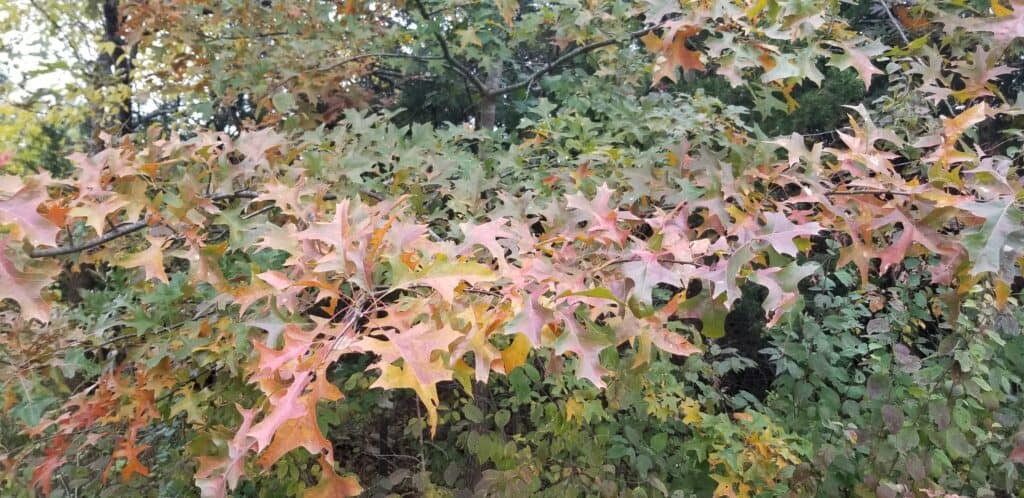
- Shingle Oak Q. imbricaria – is considered to be one of the best oak trees for landscapes. The leaves are narrow and unlobed, and are very long lived trees under cultivation. They can grow 100 feet tall.
- Blackjack Oak Q. marilandica – has one of the more interesting leaf shapes for oak trees. The leaves widen out at the end, instead of the base of the leaf. A small oak, is typically grows only 40 feet tall and wide in poor soils.
- Pin Oak Q. palustris – this is one of the most widely planted oaks in the Central Great Plains. They are fast growing and make great shade trees, but are not tolerant of high pH soils, leading to iron chlorosis. Pin oaks grow 70 to 100 feet tall and 50 to 70 feet wide.
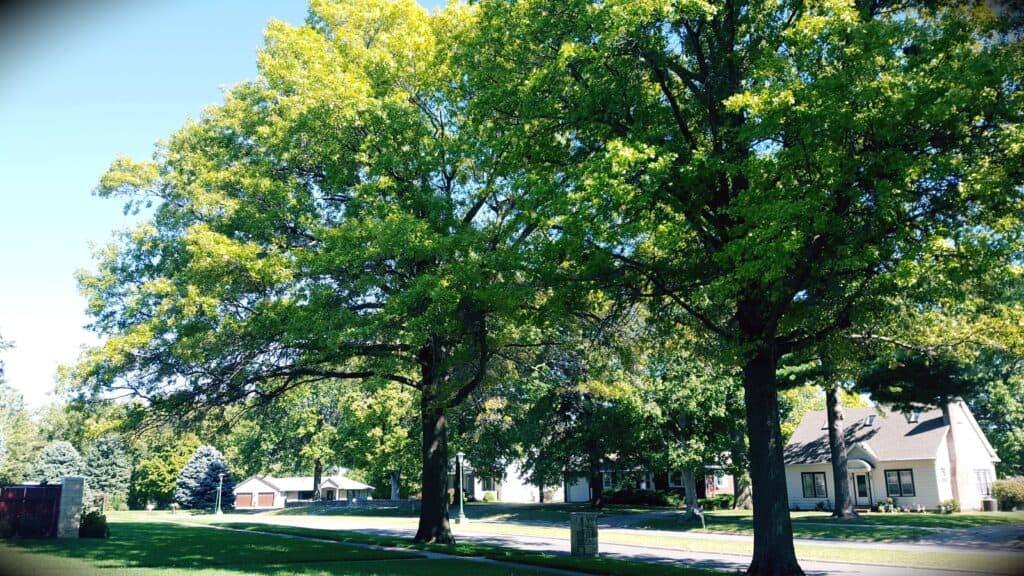
- Northern Red Oak Q. rubra – the northern red oak is another commonly planted species in landscapes. It tolerates high pH soils better, and has good red fall color. They grow 50 to 70 feet tall and wide.
- Shumard Oak Q. shumardii – One of the nicest replacement trees for the pin oak, Shumard oak can tolerate high pH soils, while giving excellent red fall color with the look of the pin oak. They often grow 100 feet tall.
- Black Oak Q. velutina – the black oak was one of the first trees I identified in my landscape, when we bought our 5 acres. Similar to the red oak in size and shape, they can be difficult to tell apart.
The White Oak Group
There are 10 species and naturally occurring hybrids in the White Oak group for our region. One of my favorites in the Dwarf Chinkapin oak, which was introduced to my by Doug Grimm, not long after I started with Grimm’s Gardens in 2011. Doug took me to a pasture north of Morrill, KS, and showed me what was then the National Champion dwarf chinkapin oak. Dwarf chinkapin oaks are small trees, found in rocky, poor soils, and they rarely get bigger than 15 feet tall and wide, making them a perfect tree for a small landscape.
Characteristics of the White Oak Group include:
- They produce the most valuable oak lumber, because the cells are leakproof.
- Their acorns mature in 1 season.
- The acorns are sweet, having almost no tannins, and are very palatable to mammals and birds.
- Inside the caps of the acorns are no hairs.
- Leaves of white oaks are either lobed with no bristle tips or unlobed and serrated with no bristle tips.
Species of the White Oak Group (True Species)
- White oak Q. alba – one of the most majestic of our North American oaks, the white oak grows up to 100 feet tall and wide, with the best fall color of the white oak group.
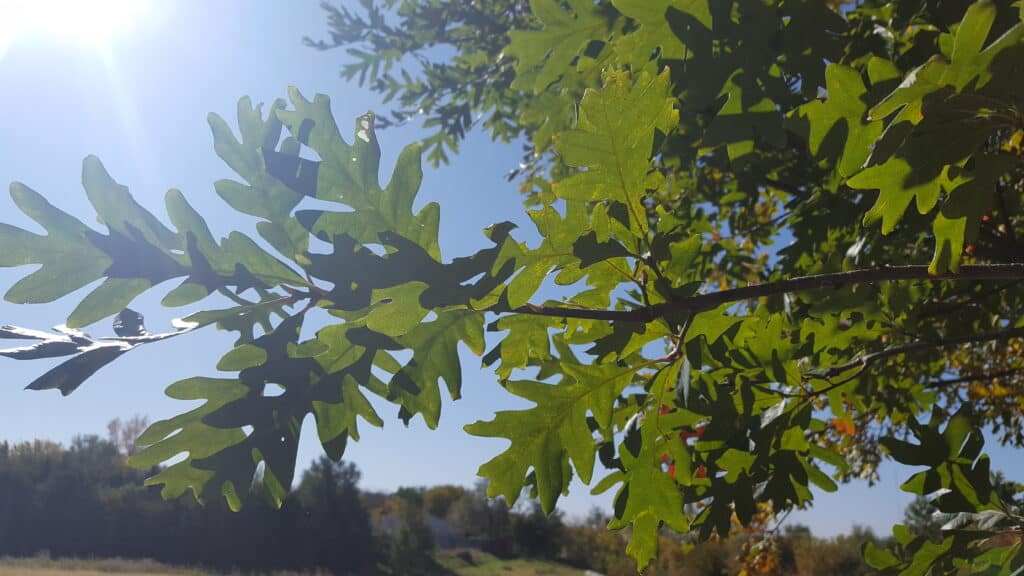
- Swamp white oak Q. bicolor – Known for its excellent acorn production at an early age, swamp white has been selected by Bucks Unlimited for planting in deer plots. They grow 60 feet tall and wide and prefer moist soils, often on the edge of floodplains or streams.
- Bur oak Q. macrocarpa – this was the only oak I knew about growing up, as it was the only native oak in Cloud County, KS. My grandparents planted on behind their home and we got seedling from its acorns at my mom’s house. Bur oaks can grow 70 to 80 feet tall and 100 feet wide.
- Chinkapin oak Q. muehlenbergii – A beautiful tree in its own rights, the chinkapin oak has narrow, serrated leaves. It grows 60 feet tall and wide and is often found growing under larger white oaks.
- Dwarf chinkapin oak Q. prinoides – as mentioned above, this is one of my favorite trees. Besides being able to grow in tough sites and smaller landscapes, they produce acorns earlier in life, making them great for deer and birds.
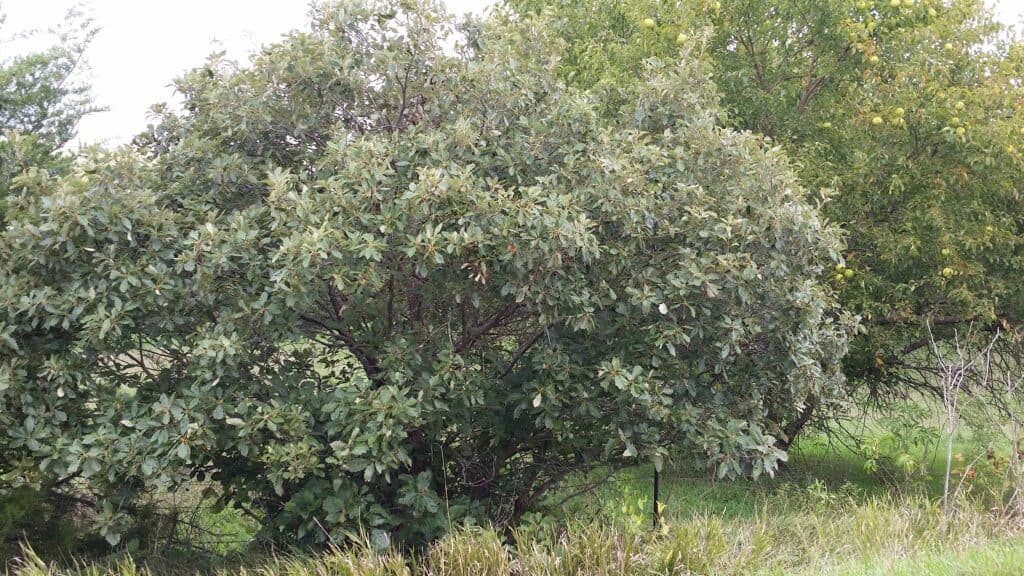
- Post oak Q. stellata – a large oak, the post oak is one of the slowest growing trees in North America. A large specimen, over 6o feet tall, may be as much as 300 years old. They average around 50 feet tall and wide, but there are several over 60 feet in Jackson Park in Atchison, KS.
Species of the White Oak Group (Naturally occurring hybrids)
- Bebb’s Oak Q. x bebbiana – a cross between white and bur oaks, Bebb’s grows 40 to 50 feet tall and wide.
- Deam’s oak Q. x deamii – this cross between chinkapin and bur is a well-known tree. A cultivar called ‘Champion Seedless’ does not produce acorns, making in valuable for landscaping.
- Fernow’s Oak Q. x fernowii – this is a cross between post oak and white oak. There have been several findings of these trees in Southeast Kansas, and are being developed into cultivars, for their great red fall color.
- Schuette’s Oak Q x schuettei – This is one of the more popular crosses. Our former arborist, Nick Haedt, really like this hybrid between bur and swamp white oak. Like the swamp white oak, Schuette’s produces acorns early.
Arthropod Associations of Oak Trees
What are arthropods? Insects, spiders, millipedes and centipedes; they all fall into this category. And oak trees have a lot of associations with these animals. In his book, Bringing Nature Home, Doug Tallamy mentions that oak tress support 534 species of lepidoptera, which is moths and butterflies. So far, in my studies of moths and butterflies in the Central Great Plains, I have identified 44 species of moths and 3 butterflies which use oak trees as a host plant. And there are many more I have yet to identify, from caterpillars feeding on oak foliage to moths laying eggs.
It is safe to say that a lot of insects feed on oak trees. Besides the lepidopteran species, all manner of insects either feed on or hunt for food on the leaves of oaks. Besides my moth ids, I have also found 20 species of galls on oaks in the Central Great Plains. One of the problems with having so many insect species feeding on oaks is that when there is a real threat to the tree, the good insects are often killed along with the bad ones.
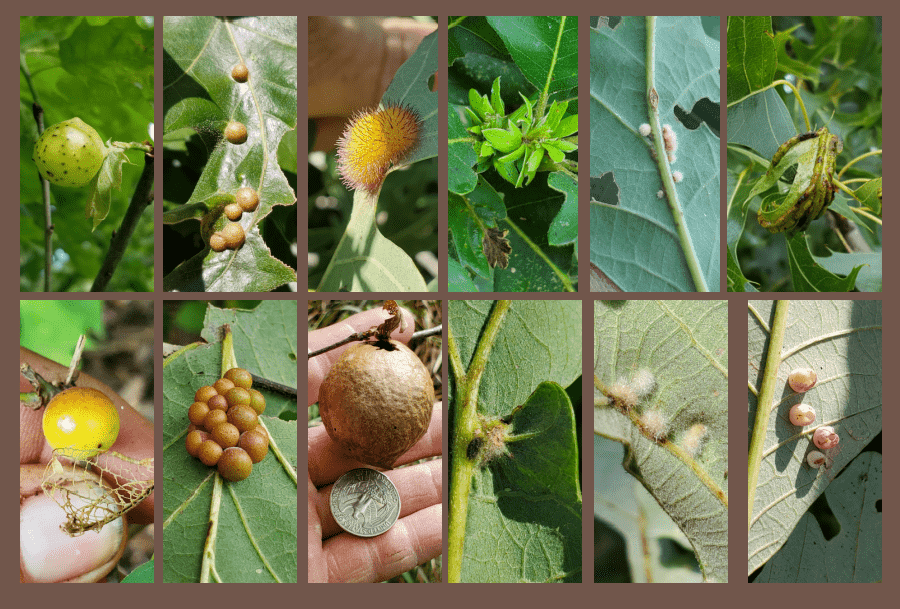
I have some customers who insist on treating their oak trees for lacebugs for example. However, the most common treatment for lacebug control is to spray a non-target specific insecticide, such as bifenthrin, on the leaves. This not only kills the lacebugs, but any predators of lacebugs, as well as caterpillars, adult moths and butterflies, beetles, and any number of other insects.
Moths and Butterflies
I have a special fondness for moths and butterflies. Besides being an advocate for pollinators, I love the diversity of lepidopterans in the landscape. There are at least 500 species of moths in Kansas, and so far, I have identified 465. And there are many I have yet to identify. I love walking through the woods and finding an adult moth sitting on a leaf, as still as can be, waiting for darkness to fly. The places where I find the most moths is in woods rich in oak species.
But why do we want so many moths eating our oaks? For the birds. Most of our native songbirds eat caterpillars when producing broods, which is of course when the caterpillars are feeding on the leaves. So, as long as there are plenty of caterpillars, there should be plenty of birds.
Besides the moths, there are a few species of butterflies which feed on oak trees. While these are not as numerous as moths, they are important and butterflies are more common pollinators than moths in our gardens.
Some of the Moth and Butterfly Species of Oak Trees
- Banded hairstreak butterfly
- Hickory hairstreak butterfly
- Horace’s duskywing skipper
- Waved sphinx moth
- American lappet moth
- Green oak-slug moth
- Hickory tussock moth
- Large tolype moth
- Polyphemus moth
- Luna moth
- Spiny oak-slug moth
- Yellow-shouldered slug moth
- Unicorn prominent
- White-dotted prominent
- Variable oak-leaf caterpillar
- Woolly gray moth

Other Insects the Specialize on Oak Trees
Besides moths and butterflies, there is a host of other insects which feed on oaks. From the aforementioned lacebugs, to the huge and wondrous walking stick, there are so many insects which feed on these trees. And many other insects, birds, reptiles, amphibians, mammals, and more feed on these various insects.
- Beetles
- True bugs
- Weevils
- Walking sticks
- Mantidflies
- Ants
- Parasitoid Wasps
- Aphids
- Lacebugs
- Katydids
- Cicadas
- Leafhoppers
- Grasshoppers

Why Animal Associations are Considered Benefits of Oak Trees
Besides the obvious reason of increased biodiversity in the landscape, having animals such as birds and mammals use oak trees is a boon to the gardener. What does all that mean? If you have a large oak tree within your landscape, and you are not treating it annually with pesticides, then you are creating a haven for wildlife that benefits you, as well as your garden.
Just by letting the oak tree be, then you are inviting insects that specialize on oaks into your garden. That in turn, invites birds and other species which feed on the insects. Birds though, rarely specialize on one set of insects or food source. That means that while they are often seen flitting about the branches of your oak, they are also flying among your flowers, vegetables, and fruit, looking for insects to eat.
Other animals too are relying on the insects of the oak for their main sustenance, but are also wandering your garden in search of things to eat. Look for tree frogs, snakes, opossums, raccoons, and others that may be using your oak tree. For example, while a raccoon is usually considered a pest animal, they may use a hollow in the tree for a home, while eating grasshoppers, cicadas, and katydids, besides other fruit and food.
Planting Oak Trees in Your Landscape
Besides being extremely important species for animal and insects in the ecosystem, oak trees are important for landscape uses. Because there are so many species of oak trees, there is one for every niche in the landscape. Now, thanks to breeding programs and nurserymen selections, we also have cultivars which are more suited for specific attributes.
What are oak trees used for in the landscape?
Besides shade, there are many uses for oaks in the landscape. One of the things to do here in the windier parts of the country, is to plant red oaks on the inner part of windbreaks. This is because many of the red oak species hold their leaves all winter, helping to reduce wind. Oak trees are also used as street trees where pollution and watering is an issue in cities. I often recommend oaks for downtowns, even if they can only be in for 10 years or less, because they can handle pollution better than many other trees.
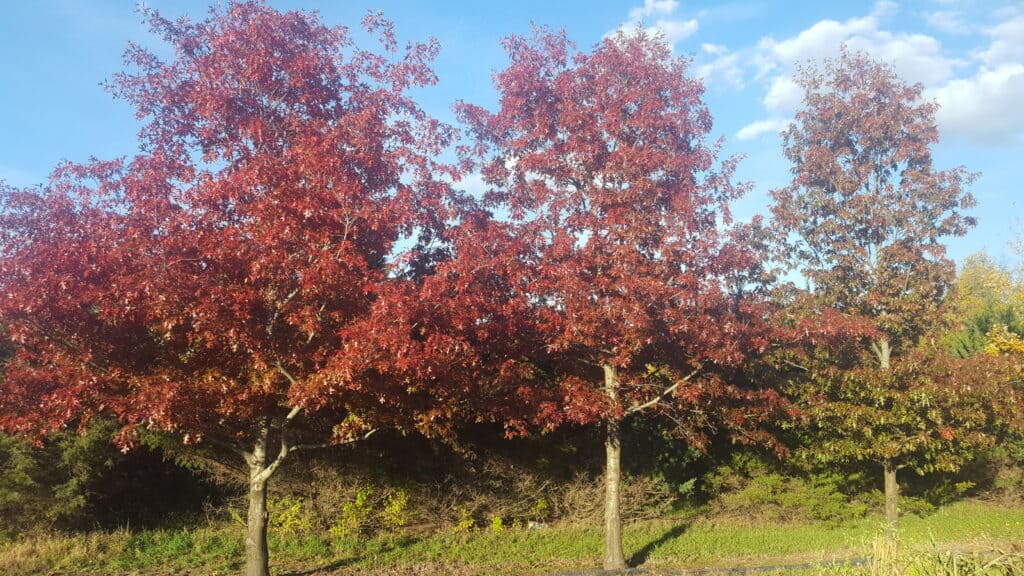
If you are wanting trees solely for fall color, consider a scarlet oak. They not only color up later than the favorite maple, but their color also lasts longer. One of my favorite trees to recommend for fall color is Doug Grimm’s selection ‘KC Infraray Red’ which I describe as having fire engine red fall foliage.
Oak trees also have massive root systems, which they start developing before even putting leaves out. This means that they can slow rainfall, and help to prevent erosion.
Conclusion
Oak trees are some of the most important trees you can plant. If you can only plant one tree in the landscape, plant an oak tree. The bees, birds, and butterflies will thank you. I have many plans for the expansion and addition of trees on my property, which includes adding 5 species of oak trees on the eastern edge. Oak trees provide shelter and protection from wind and sun, shade the house, and provide a home for many moths. Add some to your landscape, soon.
Happy planting!

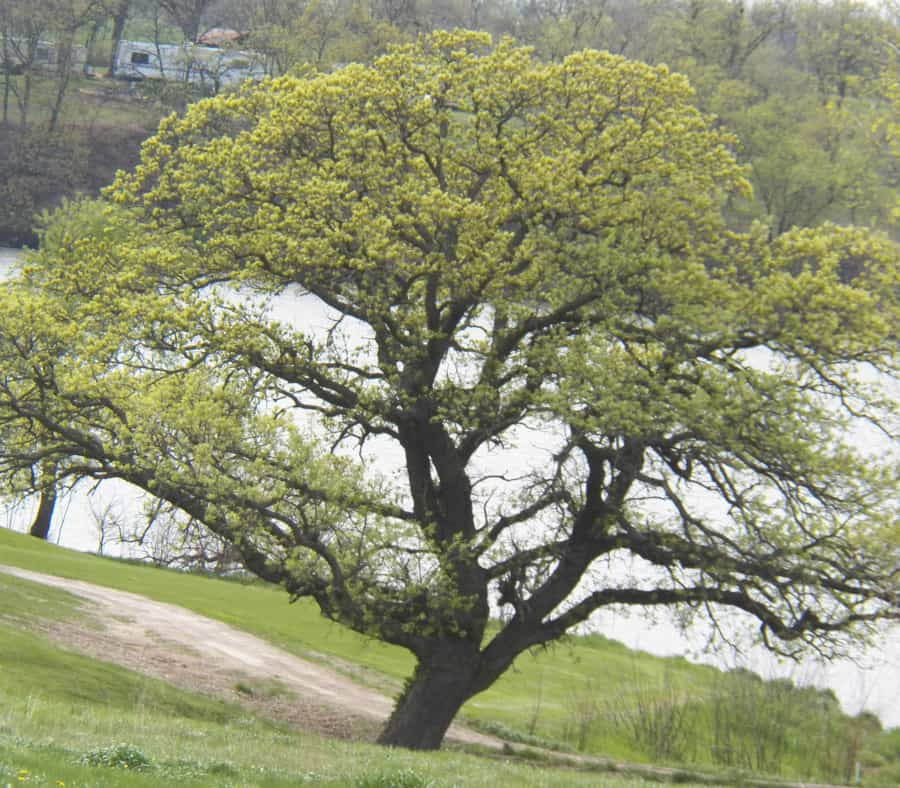



Enjoyed the article about oak trees. We have quite a few Pin Oaks on our farmstead, and also a huge Burr Oak. I have noticed that a number of old oak trees in the timber on our farms have died in the last couple of years or so. I think they are White Oaks. I wonder if other people have observed this. We live northeast of Falls City.
Hi Paul,
Thanks for commenting and reading! I have seen some death of older white and/or bur oaks around the area. I think it is mostly weather related in our area. We are still seeing effects from the flood of 2019 in combination with 3 consecutive dry falls (2020, 2021, 2022). Its a wonder that more of our trees have not died.
Thank you,
The Kansas Gardener